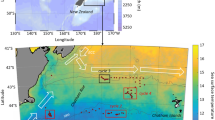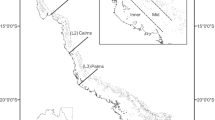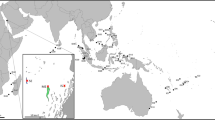Abstract
Brittle stars show rather diffuse zonation patterns with depth in the deep ocean compared to other fauna. Measurements of disk diameters of samples taken from 1973 to 1980 from populations of two species in the Rockall Trough (N.E. Atlantic Ocean) also show marked differences in frequencies of juvenile and adult sizes present at different depths. The breeding population of one of these species, Ophiocten gracilis G. O. Sars, is concentrated at about 1 000 m depth, from where samples show a polymodality in disk-size frequencies indicative of marked seasonal recruitment and von Bertalanffy growth of year classes identified from Gaussian mixtures fitted to the frequencies. A general trend of an increasing proportion of postlarval and juvenile sizes with increasing depth was evident in samples from various depths down to 2 900 m, where a marked annual settlement survives at best only a few months. However, active gametogenesis was detected in specimens as small as 1.4 mm in disk diameter and from as deep as 2 076 m. Models of age structure fitted to the size frequencies indicate a roughly depth-related gradient in decreasing survivorship and possibly also in growth rate of individuals. The population of the other species, Ophiura ljungmani Lyman, is best developed at 2 500 to 3 000 m. O. ljungmani also shows annual recruitment, and models of probable age structure fitted to samples from around 2 900 up to 1 632 m depth indicate a similar depth-related gradient in survivorship, but inconclusive evidence for depth-related differences in growth rate. With both species, certain samples from intermediate depths deviated markedly from the expectation from models of simple bathymetric gradients. This indicates that factors controlling size and age structure in these populations are complex size and age structure in these populations are complex and only indirectly related to depth. Factors controlling the patterns observed may reflect local differences in predation pressure and trophic resources as well as more direct controls such as the effect of hydrostatic pressure on physiological functions.
Similar content being viewed by others
Literature Cited
Bailey, R. S.: The population biology of blue whiting in the North Atlantic. Adv. mar. Biol. 19, 257–355 (1982)
Crisp, D. J.: Energy flow measurements In: Methods for the study of marine benthos, pp 197–279. Ed. by N. A. Home and A. D. McIntyre. Oxford: Blackwell Scientific Publications 1971. (IBP Handbook No. 16)
Ebert, T. A.: Estimating parameters in a flexible growth equation, the Richards function. Can J. Fish. aquat. Sciences 37, 687–692 (1980)
Ebert, T. A.: Recruitment in echinoderms. Proceedings of the International Echinoderms Conference, Tampa, September 1981, Ed. by J. M. Lawrence. Rotterdam: Balkema (In press)
Gage, J. D., R. H. Lightfoot, M. Pearson and P. A. Tyler: An introduction to a sample time-series of abyssal macrobenthos: methods and principle sources of variability. Oceanol. Acta 3, 169–176 (1980)
Gage, J. D., M. Pearson, A. M. Clark, G. L. J. Paterson and P. A. Tyler: Echinoderms of the Rockall Trough and adjacent areas. I. Crinoidea, Asteroidea and Ophiuroidea. Bull. Br. Mus. nat. Hist. (Ser. D). (In press)
Gage, J. D. and P. A. Tyler: Re-appraisal of age composition, growth and survivorship of the deep-sea brittle star Ophiura ljungmani from size structure in a sample time series from the Rockall Trough. Mar. Biol. 64, 163–172 (1981 a)
Gage, J. D. and P. A. Tyler: Non-viable seasonal settlement of larvae of the upper bathyal brittle star Ophiocten gracilis in the Rockall Trough abyssal. Mar. Biol. 64, 153–161 (1981 b)
Grassle, J. F., H. L. Sanders and W. H. Smith: Faunal changes with depth in the deep-sea benthos. Ambio. spec. Rep. 6, 47–50 (1979)
Hessler, R. R. and H. L. Sanders: Faunal diversity in the deep sea. Deep-Sea Res. 16, 157–170 (1967)
Macdonald, P. J. M. and T. J. Pitcher: Age-groups from size-frequency data: a versatile and efficient method of analyzing distribution mixtures. J. Fish. Res. Bd Can. 36, 987–1001 (1979)
Muus, K.: Density and growth of juvenile Amphiura filiformis (Ophiuroidea) in the Øresund. Ophelia 20, 153–168 (1981)
Nelder, J. A. and R. Mead: A simplex method for function minimisation. Comput. J. 7, 308–313 (1965)
Paterson, G. L. J., P. A. Tyler and J. D. Gage: The systematics and zoogeography of the genus Ophiocten (Echinodermata: Ophiuroidea) in the North Atlantic Ocean. Bull. Br. Mus. nat. Hist. (Zool.) 43, 109–128 (1982)
Rex, M. A.: Zonation in deep-sea gastropods: the importance of biological interactions to rates of zonations. In: Biology of benthic organisms, pp 521–530. Ed. by B. E. Keegan, P. O'Ceidigh and P. J. Boaden. Oxford: Pergamon Press 1977
Rex, M. A.: Community structure in the deep-sea benthos. A. Rev. Ecol. Syst. 12, 331–353 (1981)
Ricker, W. E.: Computation and interpretation of biological statistics of fish populations. Bull. Fish. Res. Bd Can. 191, 1–382 (1975)
Ricker, W. E.: Growth rates and models. In: Fish physiology, Vol. 8 pp 677–743. Ed. by W. S. Hoar, D. J. Randall and J. R. Brett. New York: Academic Press 1979
Sanders, H. L.: Evolutionary ecology and the deep-sea benthos. In: The changing scene in natural sciences 1776–1976, pp 223–243. Ed. by C. E. Goulden. Philadelphia: Academy of Natural Sciences 1977
Sanders, H. L. and G. F. Grassle: The interactions of diversity, distribution and mode of reproduction among major groupings of deep-sea benthos. Proc. jt oceanogr. Assem. (Tokyo) 1970, 260–262 (1971)
Schoener, A.: Evidence for reproductive seasonality in the deep sea. Ecology 49, 81–87 (1968)
Schoener, A.: Fecundity and possible mode of development of some deep-sea ophiuroids. Limnol. Oceanogr. 17, 193–199 (1972)
Schnute, J.: A versatile growth model with statistically stable parameters. Can. J. Fish. aquat. Sciences 38, 1128–1140 (1981)
Siebenaller, J. and G. N. Somero: Pressure-adaptive differences in lactate dehydrogenases of congeneric fishes living at different depths. Science, N.Y. 201, 255–257 (1978)
Sumich, J. L. and J. E. McCauley: Growth of a sea urchin, Allocentrotus fragilis, off the Oregon coast. Pacif. Sci. 27, 156–167 (1973)
Tyler, P. A.: Deep-sea ophiuroids. Oceanogr. mar. Biol. A. Rev. 18, 125–193 (1980)
Tyler, P. A. and J. D. Gage: Reproductive ecology of deep-sea ophiuroids from the Rockall Trough. In: Cyclic phenomena in marine plants and animals, pp 215–222. Ed. by E. Naylor and R. G. Hartnoll, Oxford: Pergamon Press 1979
Tyler, P. A. and J. D. Gage: Reproduction and growth of the deep-sea brittlestar Ophiura ljungmani (Lyman). Oceanol. Acta 3, 177–185 (1980)
Yamaguchi, M.: Estimating growth parameters from growth rate data. Oecologia (Berl.) 20, 321–332 (1975)
Author information
Authors and Affiliations
Additional information
Communicated by J. Mauchline, Oban
Rights and permissions
About this article
Cite this article
Gage, J., Tyler, P. Depth-related gradients in size structure and the bathymetric zonation of deep-sea brittle stars. Mar. Biol. 71, 299–308 (1982). https://doi.org/10.1007/BF00397046
Accepted:
Issue Date:
DOI: https://doi.org/10.1007/BF00397046




